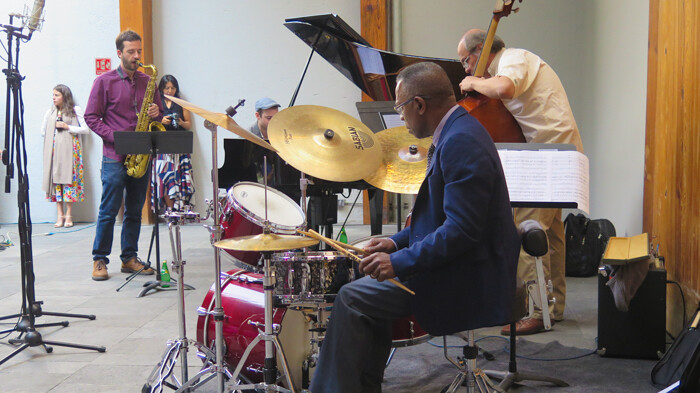November 11–December 16, 2017
What does it mean to present a group show of black artists based in the United States and United Kingdom—Mark Bradford, Charles Gaines, Rodney McMillian, Julie Mehretu, Kara Walker, and Lynette Yiadom-Boakye—in Mexico City? Here, the white/black binary of racial discourse in the US and (to a lesser extent) Western Europe is complicated by the centrality of “mestizaje” (mixed ancestry) to the national identity. While this exhibition fails to fulfill its promise to “utilize the radical language of abstraction to destabilize black representation and systems of control,” it does offer the opportunity to reflect on some of the contrasts between postcolonial societies—whether real or imagined—in North and Latin America.
“In America, I was free only in battle, never free to rest—and he who finds no way to rest cannot long survive the battle,” reads the passage by James Baldwin that inspired the show’s title.1 But what this superficial collection of “hits” by popular black artists fails to consider is the context of both the country in which it is staged and the discourse that has shaped it: globalization and (post)colonialism as a double-edged sword. Globalization homogenizes and monetizes even as it makes possible new hybrid forms, like the jazz music Charles Gaines played with his quartet during the opening, its wild, dissonant arpeggios giving way to smooth seventh chords. In an extension of a 2014 performance at MoMA, New York, the band riffed on Terry Adkins’ writings about his own practice. In the gallery, three works from Gaines’s “Manuel de Falla/Stokely Carmichael” (2016) series show the score of de Falla’s tragic opera La vida breve (1904) printed on Plexiglas, layered over a speech by Civil Rights activist Stokely Carmichael. “If you are not pure white, you’re not white,” reads one phrase.
In Mexico, the idea of La Raza Cósmica (the cosmic race), invented by José Vasconcelos in a book of the same name published in 1925, has some parallels with Afrofuturism in the US. But rather than seeing otherness as revolutionary, as Gaines suggests in the above works, the concept of mestizaje—and Vasconcelos’s idea of a future universal “fifth race”—has been idealized and romanticized even within a society stratified by class. That the best genes from Europe and the Americas mixed to create an ideal race is inherently racist, the implication being that Europeanization of the mind equals civilization, while the bodies of indigenous Mesoamericans were sexualized and eroticized as vessels. Jordan Peele’s horror film Get Out (2017) illustrates the contemporary equivalent, romanticizing the black body even while viewing black people as disposable.
Julie Mehretu’s paintings stand out as exceptional—within both the show and her own oeuvre, in which they are physically dwarfed by the artist’s epic museum works, like the vast diptych HOWL, eon (I, II) (2017) at SFMOMA. Here, the architecture of her colorful canvases on white backgrounds in her work from the early 2000s makes way for loose ink marks echoed in a large sketch by Kara Walker. But the two artists represent different perspectives on race and identity politics. Mehretu’s large-scale, gestural painting is not overtly associated with black identity—although two literally black works are on view here, Conjured Parts (found marks) (2015) and Not Yet Titled (2017)—while Walker has been accused of exoticizing and exploiting the black body through her often grotesque imagery. Unfortunately, the nuances in their approach—Mehretu’s abstraction versus Walker’s explicit illustrations—are flattened out, homogenized by their presentation in the gallery.
Rodney McMillian told press gathered for a preview that his paintings with latex house paint on secondhand bed sheets such as Roses (2016-17) are abstracted landscapes inspired by Hudson River School paintings, like Thomas Cole’s moody canvases of the Catskill mountains. But the movement’s romanticized view of nature and idea of the Americas fail to take into account the violent reality of colonization, just as the comparable nineteenth-century landscapes by José Maria Velasco in the Museo de Arte Nacional idealize the conquest of the Valley of Mexico. Both colonial painting movements exoticize the Americas as a wild place to be tamed, but their differences offer insight into two different perspectives on race. In McMillian’s version of an American landscape, Rat brain (2017), a bed sheet from a thrift store and paint returned to Home Depot combine in a portrait of economy in the United States. In this grimy urbanized landscape a rat in the artist’s studio eats the artwork, leaving little paw prints in the paint and colorful pellets of feces on the floor. “Brain turned black after all day at a public university, even a rat had to flee,” reads a handwritten note stapled to the bed sheet.
Viewers in Mexico will make connections between the work in “Never Free to Rest” and their own national context, even if the gallery missed the opportunity to expand the topics of the show by including an Afro-Latinx artist or by commissioning an essay to provide context about race and class in Mexico. For all its failures, however, the exhibition attempts to encourage reflections on race that cross the Mexican border, creating a bridge between two discourses that are increasingly inward-looking.
James Baldwin, “No Name in the Street,” in Collected Essays, ed. Toni Morrison (New York: Library of America, 1998), 430.








